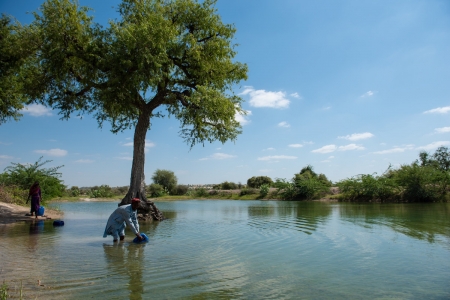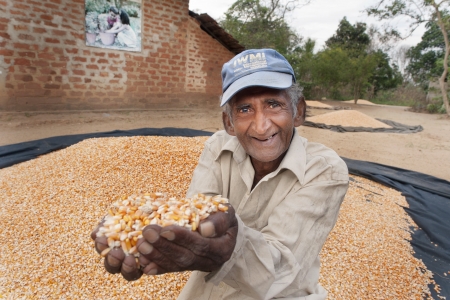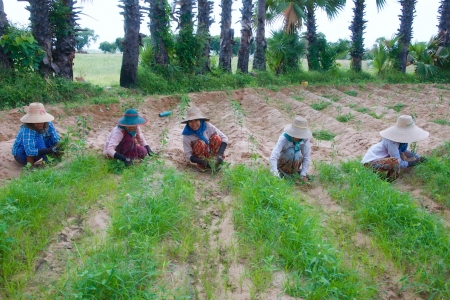As a major gathering of experts on migration convenes in Delhi this week, Priyanie Amerasinghe and Fraser Sugden, heads of the International Water Management Institute (IWMI)'s Delhi and Kathmandu offices respectively, explain why understanding water access is critical to understanding why many people move for work.
As winter sets in in Thadi Jijha in Nepal’s Tarai region, there are few men to be found. The harvest has been gathered, and with prospects of rain limited until the next monsoon, very little can be grown in the fields, gardens and vegetable patches. To survive, many men head for India, while an even greater number migrate on a long term basis, to the Gulf States or Malaysia. It is a pattern that repeats itself annually, and show no signs of relenting.

“We are so poor that we need to do menial work,” says Bimli Thakur, a local woman interviewed for an IWMI research project whose husband is in the Gulf. “People say ‘you get remittances so you are rich’, but with dowries to pay for my daughters, I am under pressure from all sides. I just want to learn some skills.”
“People find it very difficult to survive,” says Kiran Sah, also interviewed for the research project and one of the few men still farming in the nearby Sarabe village. “There is a lack of irrigation and farming requires a lot of fertilizers and investment. We always advise our families to migrate abroad.”
This mass migration is not just across borders. Within India many hundreds of thousands of smallholder farmers are forced to look for work in urban centres during the Rabi season simply because they cannot get enough water to farm. With climate stress each year, persisting land inequalities, and a poor terms of trade for agriculture, migration is increasingly not just seasonal, but long term, with men residing in cities for extended spells and returning only periodically for family business.
The numbers are staggering. According to UN figures, in India alone 400 million, or nearly one third of the total population, migrate to work at some point in their lives. Every year, up to 3 million Nepalis seek work in India. Of course, a flexible and mobile labour market might be regarded by many as economically efficient – even desirable. But there is a big difference between an educated graduate moving to the city for better job opportunities, and frustrated people leaving their families in order to augment a meagre income.
Every village has its migrant success stories, where farmers return to invest in new land, a concrete house or a vehicle. Although these cases are highly visible and much hyped, they mask the fact that for a majority of migrants to Indian cities are engaged in casual, menial and low paid labor. Similarly, higher wages earned by migrants to the Gulf are offset by crippling debts accrued to pay the middlemen who send them abroad. Exploitation and deception by agents or employers are widespread, often causing huge losses for migrants.
The income accumulated by most migrant laborers is seldom sufficient to enable their families to be lifted out of poverty. With more resources, smallholder farmers, for instance, could invest in new technologies to expand production. A simple well or pond and motorized pump might transform the prospects of a farm, allowing for an extra harvest in the spring and offsetting the pressures of climate change.
But even when migrants bring back small amounts money, there is rarely much incentive to invest this in agriculture. This is aggravated by a spiraling cost of living. When savings are made by migrants in Bihar and the Nepal Tarai, these are often spent on increasingly costly dowry demands or weddings.
A consequence of the migrant boom, is that many farms are run by women for much of the year. The 2011 census in Nepal, for instance, revealed that over a quarter of all households were headed by women. While this can increase women’s bargaining power, women are shouldered with a huge work burden, and what is received by remittances is often just enough to meet immediate food needs and not to invest on productivity improving inputs.
People should be allowed and even, in some circumstances, encouraged to move for work. But the current structure of migration, particularly in the Ganges plains, contributes to the reproduction of rural poverty. This can be addressed, but it will take a multi-faceted approach to deliver sustainable progress. Women’s status needs to be improved so that they can gain more control over resources. Land tenure should be reformed so farmers can get security and collateral. Policy makers should explore whether farming cooperatives could be encouraged which can collectively invest in new technology. Better targeted subsidies or loans could also make a huge difference.
There will doubtless always be migrants; a restless search for better opportunities is instinctively human. But unless we can address some of the root causes of current migrations, sustainable development, food security and the quest for more equal gender rights may all be imperiled.
The international workshop on outward migration and feminization of agriculture in South Asia took place in New Delhi on 26 and 27 November.
A version of this article first appeared in The Kathmandu Post.









